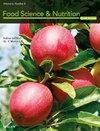Phenolic contents and antioxidant activities of Caucasian bee propolis at different locations, solvents, and temperatures
IF 3.5
2区 农林科学
Q2 FOOD SCIENCE & TECHNOLOGY
引用次数: 0
Abstract
Propolis is a natural substance produced by honey bees by processing the secretions collected from various plants with their own enzymes. Caucasian honey bee is one of the productive bee races known in the world and its homeland in Türkiye is Northeastern Anatolia. This study is the first comprehensive research to determine, compare, and correlate the effects of various solvents and temperatures on 17 different Caucasian bee propolis obtained from different locations in terms of phenolic content and antioxidant activity. The highest total polyphenol and flavonoid contents (TPC and TFC) in Caucasian bee propolis extracts varied between 23.37–97.62 mg gallic acid per gram (GA/g) of propolis and 6.73–43.75 mg quercetin per gram (Q/g) of propolis in ethanolic extract at 60°C. While ferric reducing antioxidant power (FRAP) did not differ at both temperatures, the highest was determined in ethanolic extracts. Analyses of propolis samples according to locations did not show any significant differences in terms of TPC, TFC, and FRAP. By Pearson's correlation analysis, it was found that each of the extracts showed a positive correlation between TPC, TFC, and FRAP. As a result, it was revealed that the main difference in the phenolic content and antioxidant activities of propolis obtained from gene centers of Caucasian bee race was due to the polarity of the solvent used and temperature, and that there was no difference between locations within a single bee race. This pioneering study shows that Caucasian bee propolis has a high potential that can pave the way for different research in this field.不同地点、溶剂和温度下高加索蜂胶的酚含量和抗氧化活性
蜂胶是蜜蜂用自身的酶处理从各种植物中采集的分泌物而产生的天然物质。高加索蜜蜂是世界上已知的高产蜂种之一,它在土耳其的故乡是安纳托利亚东北部。本研究是首次全面研究确定、比较和关联各种溶剂和温度对从不同地点获得的 17 种不同高加索蜂胶的酚含量和抗氧化活性的影响。在 60°C 的乙醇提取物中,高加索蜂胶提取物中的总多酚和类黄酮含量(TPC 和 TFC)最高,分别为每克蜂胶 23.37-97.62 毫克没食子酸(GA/g)和每克蜂胶 6.73-43.75 毫克槲皮素(Q/g)。铁还原抗氧化力(FRAP)在两种温度下没有差异,但乙醇提取物中的铁还原抗氧化力最高。根据不同地点对蜂胶样品进行的分析表明,在 TPC、TFC 和 FRAP 方面没有任何显著差异。通过皮尔逊相关分析发现,每种提取物的 TPC、TFC 和 FRAP 之间都呈正相关。结果表明,从高加索蜂种基因中心提取的蜂胶,其酚类物质含量和抗氧化活性的主要差异在于所用溶剂的极性和温度,而在同一蜂种中,不同地点的蜂胶并无差异。这项开创性的研究表明,高加索蜂胶具有很大的潜力,可以为这一领域的不同研究铺平道路。
本文章由计算机程序翻译,如有差异,请以英文原文为准。
求助全文
约1分钟内获得全文
求助全文
来源期刊

Food Science & Nutrition
Agricultural and Biological Sciences-Food Science
CiteScore
7.40
自引率
5.10%
发文量
434
审稿时长
24 weeks
期刊介绍:
Food Science & Nutrition is the peer-reviewed journal for rapid dissemination of research in all areas of food science and nutrition. The Journal will consider submissions of quality papers describing the results of fundamental and applied research related to all aspects of human food and nutrition, as well as interdisciplinary research that spans these two fields.
文献相关原料
| 公司名称 | 产品信息 | 采购帮参考价格 |
|---|
 求助内容:
求助内容: 应助结果提醒方式:
应助结果提醒方式:


